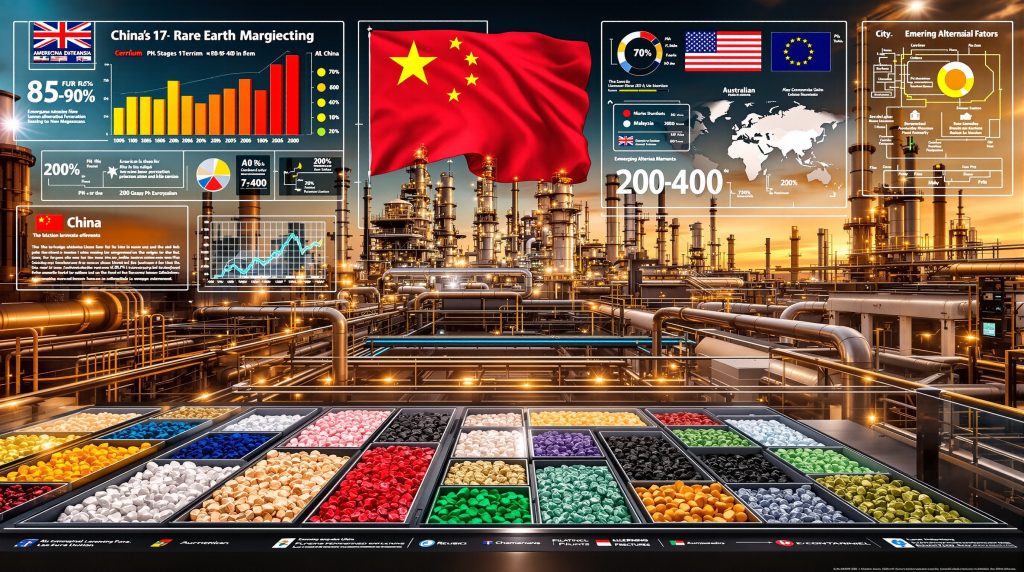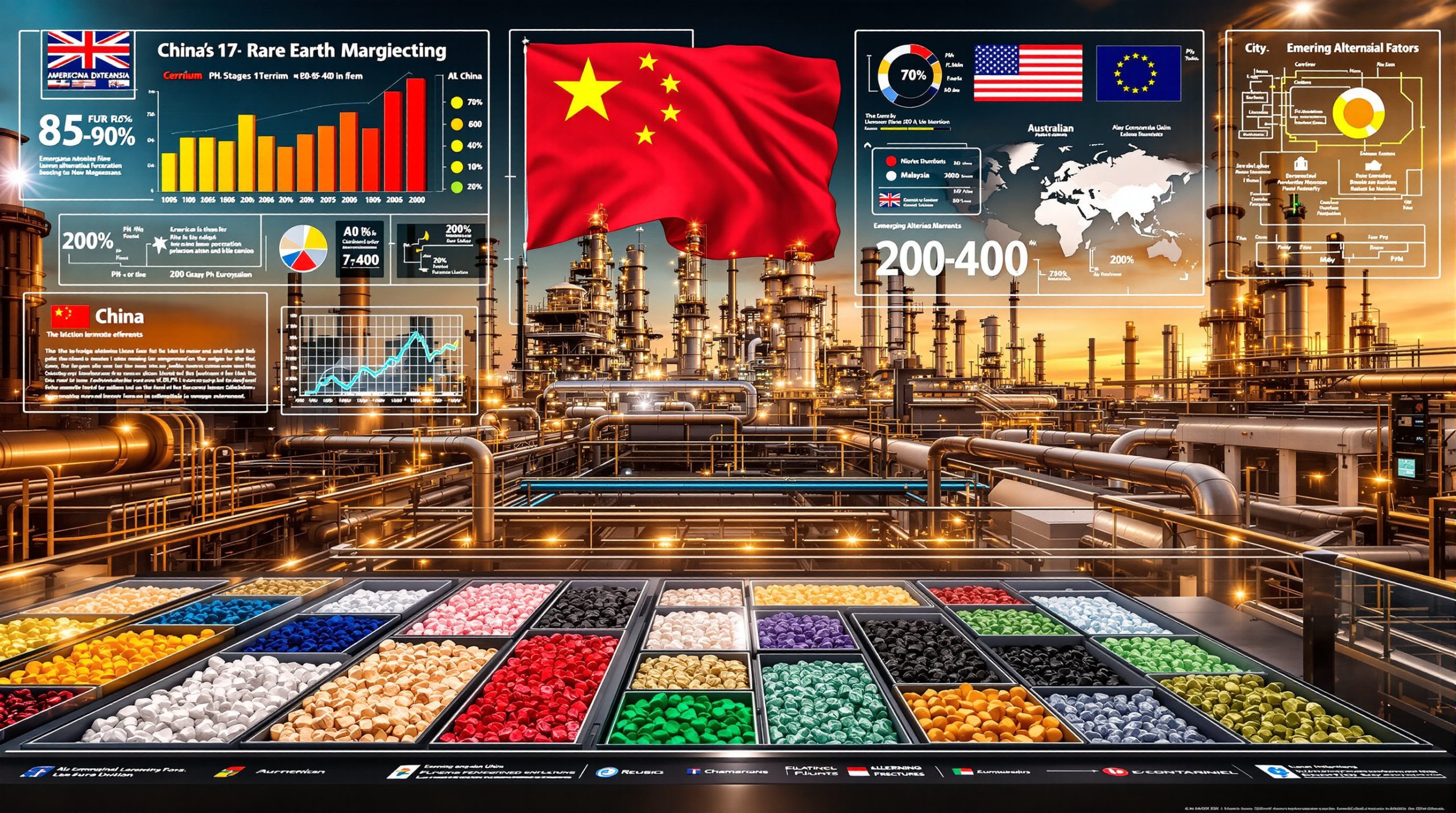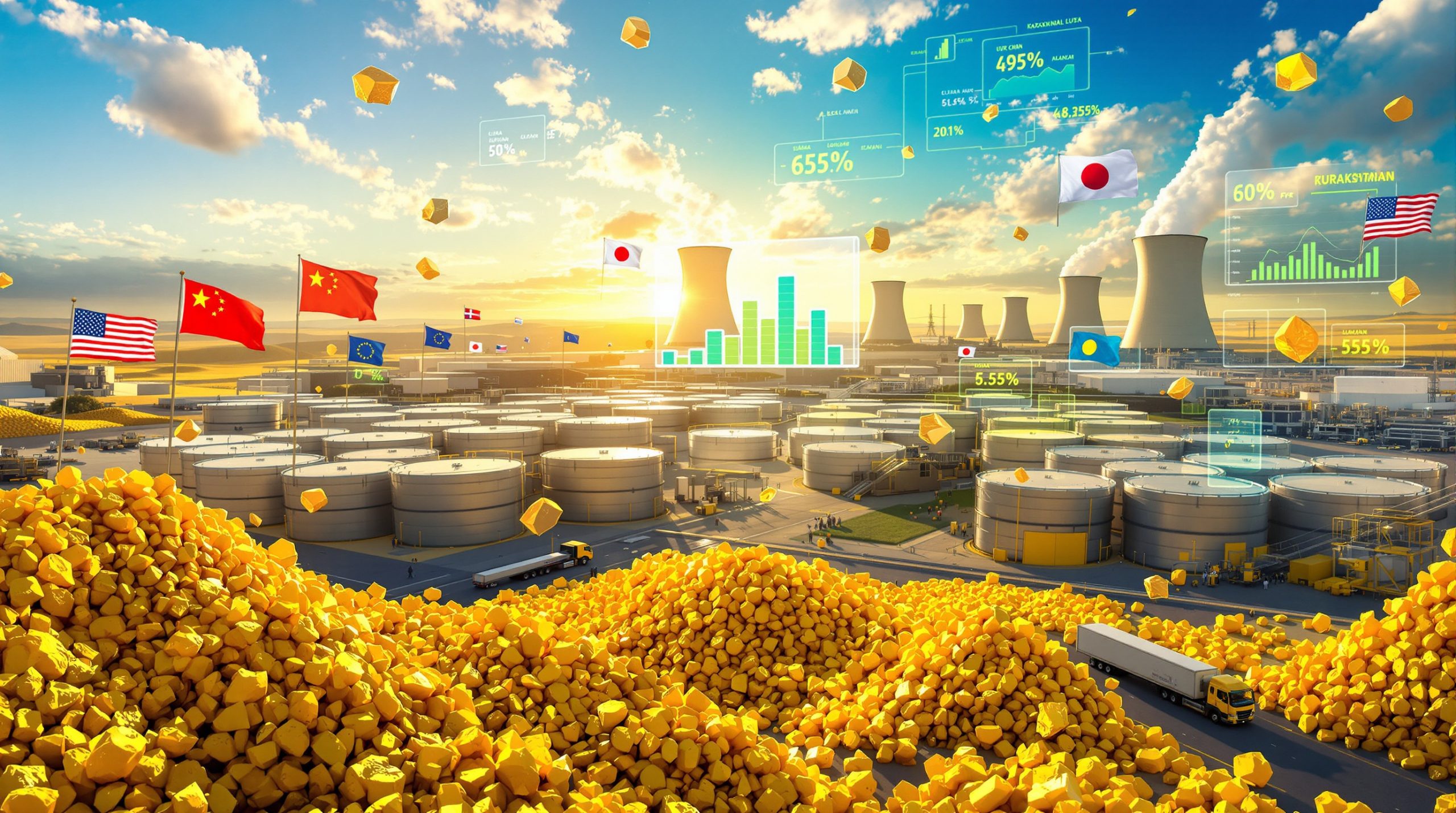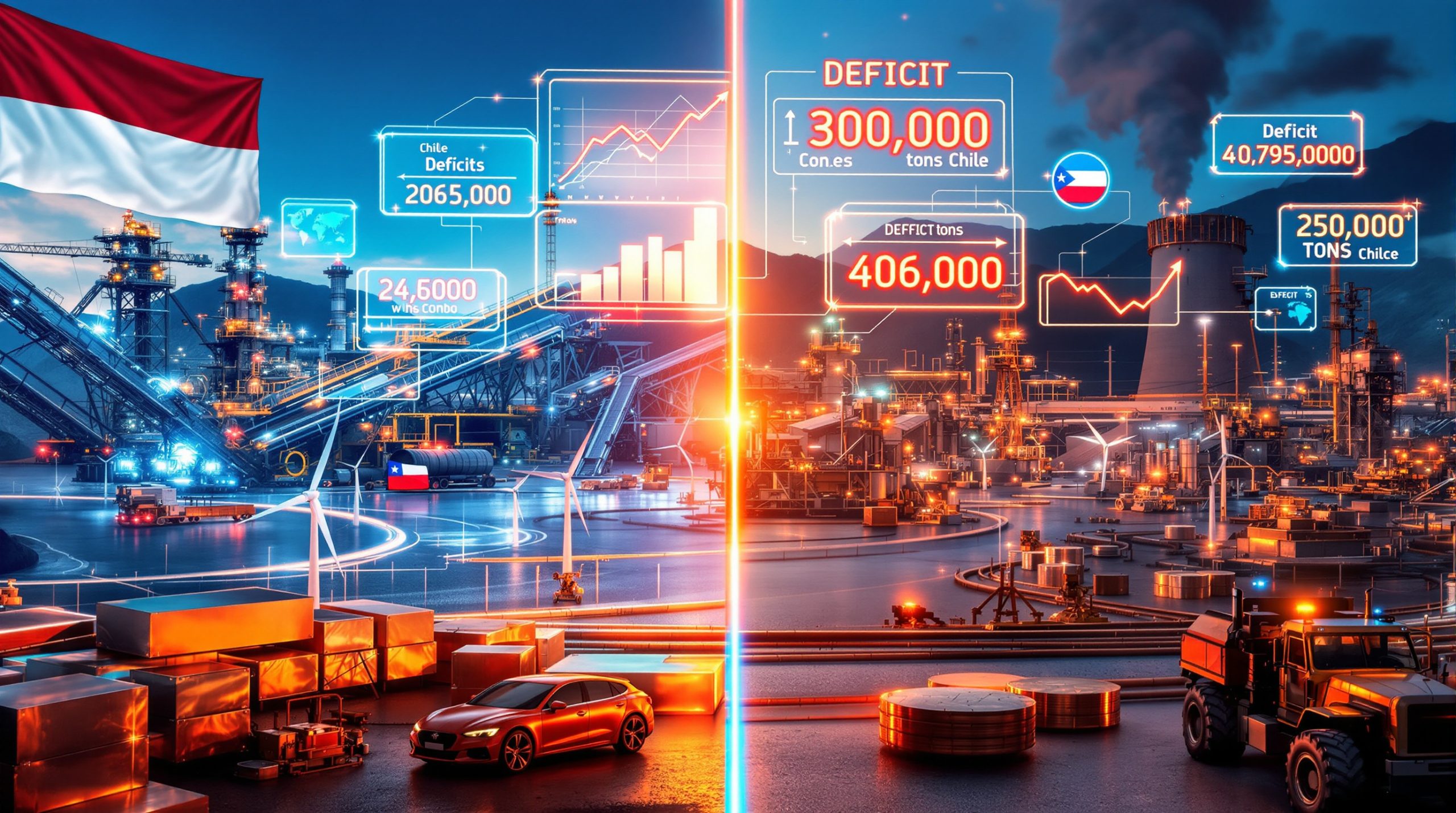Strategic Dependencies in Critical Materials Processing
Global supply chains for advanced technologies rest upon a foundation few understand: the specialised industrial processes that transform raw materials into usable components. When examining critical materials like rare earth elements, the most vulnerable point lies not in extraction from the ground, but in the complex refining stages that follow. This rare earth refining bottleneck represents one of the most significant strategic dependencies in modern industrial systems, where technical complexity, environmental challenges, and geopolitical considerations converge to create chokepoints that can affect entire economic sectors. Furthermore, understanding critical minerals energy transitions becomes crucial in this context.
The concentration of processing capacity in a single nation creates systemic risks that extend far beyond traditional market dynamics. Unlike conventional commodities where multiple suppliers can quickly scale production, rare earth processing requires decades of institutional knowledge, specialised infrastructure, and tolerance for environmental externalities that few nations possess. Understanding this bottleneck requires examining not just the technical barriers, but the strategic decisions that led to this concentration and the pathways available for diversification.
The Technical Architecture of Processing Dominance
Rare earth refining represents one of the most technically demanding processes in industrial chemistry. The seventeen elements classified as rare earth elements share remarkably similar chemical properties, making their separation an exercise in precision that requires hundreds of individual extraction stages. This similarity stems from their electron configurations, where differences occur only in inner electron shells, creating minimal variation in chemical behaviour.
The primary separation method, solvent extraction, involves creating carefully controlled chemical environments where minute differences in element behaviour can be exploited. A single commercial facility may require 200-400 individual separation stages, each operating within precise parameters of temperature, acidity, and reagent concentration. Moreover, the process demands continuous monitoring and adjustment, as variations of even 0.1 pH units can compromise separation efficiency and product purity.
Critical Technical Parameters:
• Temperature control within ±2°C across multiple process streams
• pH maintenance between 0.5-6.0 depending on separation stage
• Reagent purity requirements exceeding 99.5% for optimal efficiency
• Processing times ranging from 48-120 hours for complete cycles
• Quality control testing at 15-20 intermediate stages
The environmental engineering requirements add another layer of complexity. Processing facilities must handle radioactive thorium and uranium byproducts naturally present in rare earth ores, requiring specialised waste management systems and radiation monitoring. Additionally, the chemical intensity of the process generates 10-15 tonnes of contaminated wastewater for every tonne of rare earth oxide produced, necessitating extensive treatment capabilities that meet increasingly stringent environmental standards.
Economic Foundations of Market Concentration
The economics underlying rare earth processing reveal why market concentration occurred and persists despite growing geopolitical tensions. Capital requirements for establishing commercial-scale separation facilities range from $300-500 million, excluding environmental management infrastructure and working capital needs. These figures represent entry barriers that discourage speculative investment and require either substantial government backing or long-term offtake agreements to justify. Furthermore, recent mining innovation trends highlight the evolving technological landscape in this sector.
Facility Development Cost Structure:
| Component | Investment Range (USD) | Timeline | Risk Factors |
|---|---|---|---|
| Core Processing Equipment | $200-350M | 18-24 months | Technology obsolescence |
| Environmental Systems | $80-150M | 12-18 months | Regulatory changes |
| Site Infrastructure | $40-80M | 6-12 months | Permitting delays |
| Contingency & Commissioning | $50-100M | 6-18 months | Technical challenges |
Operating cost differentials explain the persistence of geographic concentration even as strategic concerns mount. Chinese facilities benefit from lower labour costs, relaxed environmental enforcement, and integrated supply chains that reduce transportation and inventory expenses. Consequently, Western facilities face 3-4x higher labour costs and environmental compliance expenses that can add 25-35% to total operating costs.
The learning curve effects compound these challenges. Facilities require 2-3 years of operational experience to optimise separation processes and achieve target purity levels. During this period, production costs can exceed revenues by 40-60%, creating cash flow pressures that have historically forced Western projects to seek Chinese partnerships or abandon operations entirely.
Institutional Knowledge and Human Capital Constraints
Perhaps the most underappreciated aspect of the rare earth refining bottleneck involves human capital limitations. Rare earth separation combines metallurgical engineering, analytical chemistry, and process optimisation in ways that require years of hands-on experience to master. The number of engineers globally with deep expertise in rare earth processing is estimated at fewer than 200 individuals, with approximately 80% located in China.
This expertise gap reflects decades of Western industrial policy that prioritised moving "dirty" processing offshore while retaining higher-value activities. The unintended consequence was the loss of institutional knowledge that cannot be quickly recreated through academic training or technology transfer. In addition, universities in Western nations offer limited coursework in rare earth chemistry, and practical training opportunities remain scarce outside existing Chinese facilities.
Critical Skill Requirements:
• Solvent extraction process optimisation (3-5 years experience minimum)
• Analytical chemistry for rare earth purity verification
• Environmental engineering for radioactive waste management
• Process control systems for continuous separation operations
• Quality assurance protocols for 99.9%+ purity requirements
The knowledge transfer challenge extends to operational procedures and troubleshooting protocols. Each rare earth deposit presents unique mineralogy and chemistry that affects separation efficiency. Understanding how to adjust processes for different feedstocks requires experiential knowledge that cannot be easily codified in technical manuals or training programs.
Geopolitical Leverage and Strategic Vulnerability
China's dominance in rare earth refining creates asymmetric leverage that extends well beyond traditional trade relationships. By controlling 85-90% of global separation capacity and 95% of heavy rare earth processing, China possesses the ability to disrupt supply chains for defence systems, renewable energy infrastructure, and consumer electronics simultaneously.
This leverage operates through multiple mechanisms beyond direct export restrictions. China can prioritise domestic demand during periods of high consumption, effectively rationing global supply without explicit export controls. Additionally, Chinese firms can adjust production schedules or maintenance timing to influence global pricing and inventory levels, creating uncertainty that discourages long-term planning by downstream manufacturers.
Strategic Vulnerability Assessment:
| Sector | Rare Earth Dependency | Supply Disruption Impact | Alternative Timeline |
|---|---|---|---|
| Defence Electronics | Critical | Mission capability loss | 3-5 years |
| Electric Vehicle Motors | High | Production halt | 2-4 years |
| Wind Turbine Generators | High | Installation delays | 3-6 years |
| Smartphone Displays | Medium | Cost increase | 1-2 years |
The vulnerability extends to recycling operations, where China also maintains significant capacity advantages. End-of-life rare earth recovery requires similar separation expertise and infrastructure, meaning that even circular economy strategies currently depend on Chinese processing capabilities. However, there are growing opportunities in mineral beneficiation insights that could help diversify processing capabilities.
Technical Innovation and Alternative Pathways
Emerging technologies offer potential pathways to reduce dependence on traditional separation methods, though commercial viability remains years away. Membrane separation technologies could reduce chemical consumption by 40-60% while simplifying plant design, but current methods cannot achieve the purity levels required for high-performance applications.
Biotechnology approaches using engineered microorganisms show promise for selective element recovery from low-grade ores or waste streams. However, scaling biological processes from laboratory demonstrations to commercial production presents challenges similar to those faced by chemical separation, requiring specialised bioreactors and sterile processing environments.
Innovation Development Timeline:
• Near-term (1-3 years): Process optimisation and automation improvements
• Medium-term (3-7 years): Membrane and electrochemical separation pilots
• Long-term (7-15 years): Biotechnology and alternative chemistry commercialisation
Electrochemical separation methods eliminate organic solvents and reduce waste generation, but current energy requirements make them economically unviable except for high-value heavy rare earths. Continued development could make these methods competitive for specific applications where environmental benefits justify higher costs.
What drives the West's scramble for rare earth alternatives?
The Western scramble to address rare earth dependencies intensifies as geopolitical tensions highlight supply chain vulnerabilities. In addition, the development of sustainable mining transformation practices becomes increasingly important as countries seek to develop alternative processing capabilities whilst maintaining environmental standards.
Investment Requirements and Funding Mechanisms
Addressing the rare earth refining bottleneck requires sustained financial commitment on a scale that exceeds private market capabilities. Conservative estimates suggest $15-25 billion in capital investment over 10-15 years to establish meaningful alternative processing capacity representing 30-40% of current Chinese production.
Government support programmes recognise this funding gap and have allocated substantial resources, though implementation timelines remain extended. The U.S. Defense Production Act has committed $1.5 billion for critical materials infrastructure, while the European Union's Critical Raw Materials Act targets €3 billion in related investments.
International Funding Initiatives:
• United States: Defense Production Act funding ($1.5B allocated)
• European Union: Critical Raw Materials Act (€3B commitment)
• Japan-Australia Partnership: Joint processing facilities ($2B)
• Canada: Critical Minerals Strategy ($1.5B over 10 years)
Private sector participation faces challenges beyond capital requirements. Return on investment timelines of 8-12 years discourage many institutional investors, particularly when competing against subsidised Chinese capacity. Risk premiums for first-of-kind facilities can add 2-4% to borrowing costs, further extending payback periods.
How do processing bottlenecks affect trade relationships?
The rare earth bottleneck creates complex trade dynamics that extend beyond traditional commodity markets. Furthermore, establishing a critical raw materials facility becomes essential for maintaining strategic autonomy in critical supply chains.
Supply Chain Resilience Strategies
Developing supply chain resilience requires more than simply replicating Chinese processing capacity in Western locations. Effective strategies must account for the integrated nature of rare earth supply chains and the interdependencies between mining, processing, and manufacturing stages.
Stockpiling represents a near-term mitigation strategy that can provide 6-18 months of buffer capacity for critical applications. However, the diversity of rare earth elements and their varying strategic importance complicates inventory management and requires sophisticated demand forecasting to avoid obsolescence or shortages.
Resilience Strategy Components:
• Strategic stockpiling for 12-24 month supply security
• Diversified supplier relationships across multiple geographic regions
• Accelerated recycling programmes for end-of-life products
• Alternative material development reducing rare earth requirements
• International cooperation agreements for shared processing infrastructure
Recycling initiatives offer particular promise for heavy rare earth elements, where urban mining from electronic waste can provide significant supply supplements. However, collection systems and processing infrastructure for rare earth recovery remain underdeveloped, requiring coordination across multiple industries and regulatory jurisdictions.
Market Psychology and Investment Patterns
Investor behaviour in rare earth markets reflects the complex interplay between long-term strategic value and short-term volatility challenges. Price cycles driven by Chinese export policies create boom-bust patterns that discourage sustained capital investment in alternative processing capacity.
The psychology of rare earth investing involves balancing certain long-term demand growth against uncertain supply chain developments and technological substitution risks. Projects that appear economically viable during price spikes often become uneconomical when Chinese supply increases and prices normalise.
Investment Decision Factors:
• Long-term offtake agreements providing revenue certainty
• Government support reducing development risk and capital requirements
• Technological differentiation enabling premium pricing
• Strategic importance overriding short-term economic considerations
• Partnership opportunities with downstream manufacturers
Understanding these dynamics helps explain why rare earth processing capacity has remained concentrated despite repeated efforts at diversification. Success requires alignment of strategic incentives, financial support, and technological capabilities over extended timeframes that challenge conventional investment models.
Environmental and Regulatory Complexity
Environmental considerations represent both a barrier to capacity development and a potential differentiator for Western processing facilities. Rare earth separation generates significant quantities of acidic wastewater, radioactive sludge, and atmospheric emissions that require sophisticated management systems.
Modern environmental standards effectively prohibit the waste disposal practices that enabled early Chinese cost advantages. Western facilities must incorporate comprehensive waste treatment, groundwater monitoring, and air quality controls that can represent 20-30% of total capital investment.
Environmental Management Requirements:
• Radioactive waste containment and long-term storage
• Acid-resistant infrastructure preventing groundwater contamination
• Air emission control systems for volatile organic compounds
• Waste minimisation through reagent recycling and process optimisation
• Continuous environmental monitoring and reporting systems
These requirements, while adding cost and complexity, also create opportunities for technological leadership and premium market positioning. Facilities that demonstrate superior environmental performance may access markets and customers willing to pay premiums for responsibly sourced materials.
Future Scenarios and Strategic Implications
Scenario planning for rare earth supply chains must account for multiple variables including Chinese policy decisions, technological breakthroughs, and evolving demand patterns from emerging applications. The intersection of these factors creates a complex decision environment where traditional forecasting approaches prove inadequate.
Key Scenario Variables:
• Chinese export policy changes affecting global supply availability
• Breakthrough technologies enabling alternative separation methods
• Demand growth from electric vehicles and renewable energy systems
• Recycling technology improvements increasing secondary supply
• Geopolitical tensions influencing trade relationships and technology transfer
The most likely scenario involves gradual diversification of processing capacity over 10-15 years, with Chinese dominance declining to 60-70% of global capacity. However, this outcome depends on sustained government support for alternative capacity development and successful technology commercialisation by Western firms.
Alternative scenarios range from continued Chinese dominance if diversification efforts fail, to rapid supply chain restructuring if geopolitical tensions escalate significantly. Each scenario carries different implications for investment strategies, policy responses, and technological development priorities.
Practical Implications for Stakeholders
The rare earth refining bottleneck affects different stakeholders in distinct ways, requiring tailored response strategies that account for specific vulnerabilities and capabilities. Understanding these implications helps frame appropriate risk management and strategic planning approaches.
For defence and aerospace manufacturers, supply security takes precedence over cost considerations, justifying premium prices for non-Chinese supply sources. These sectors can support early-stage alternative processing capacity through long-term contracts that improve project economics for developers.
Consumer electronics and automotive manufacturers face different trade-offs between cost, quality, and supply security. These industries may pursue dual-sourcing strategies or develop alternative designs that reduce rare earth requirements whilst maintaining performance standards.
Stakeholder Response Strategies:
• Government Agencies: Strategic stockpiling and infrastructure investment
• Defence Contractors: Premium sourcing and vertical integration
• Technology Companies: Design optimisation and material substitution
• Mining Companies: Downstream integration and processing partnerships
• Investors: Long-term positioning and policy-supported opportunities
The complexity of rare earth supply chains requires sophisticated risk assessment and management approaches that extend beyond traditional procurement strategies. Success depends on understanding both technical constraints and geopolitical dynamics that influence market development over extended timeframes.
Conclusion: Navigating Strategic Dependencies
The rare earth refining bottleneck represents a convergence of technical complexity, economic concentration, and strategic vulnerability that cannot be quickly resolved through market mechanisms alone. Decades of industrial development, knowledge accumulation, and infrastructure investment have created advantages that resist rapid replication.
Addressing this bottleneck requires coordinated action across multiple dimensions including technology development, human capital formation, environmental management, and strategic planning. The timeline for meaningful diversification extends well beyond typical business planning horizons, demanding sustained commitment from both public and private stakeholders.
This analysis is based on publicly available information and industry assessments current as of November 2025. Future developments in technology, policy, and market conditions may significantly alter the dynamics described. Readers should consult current sources and professional advisors when making specific investment or strategic decisions related to rare earth supply chains.
Are You Tracking Critical Mineral Investment Opportunities?
Discovery Alert's proprietary Discovery IQ model delivers instant notifications on significant ASX mineral discoveries in critical materials sectors, empowering investors to identify actionable opportunities ahead of the broader market. With major discoveries historically generating substantial returns, explore Discovery Alert's dedicated discoveries page to understand the potential impact of strategic mineral investments, then begin your 30-day free trial to secure your market-leading advantage.




